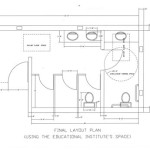Installing a Bathroom Exhaust Vent Through a Rooftop Ceiling
Bathroom exhaust vents are crucial for maintaining a healthy and comfortable environment within a home. They effectively remove moisture, odors, and pollutants generated from showering, bathing, and toilet use. When properly installed, a bathroom exhaust vent prevents the accumulation of mildew, mold, and structural damage caused by excessive humidity. Venting to the exterior of the house is paramount for effective removal, and routing through the roof can be a viable option, especially in situations where wall venting is impractical or undesirable. This article provides a comprehensive guide to installing a bathroom exhaust vent through a rooftop ceiling.
Before commencing any installation project, a thorough assessment of the bathroom and attic space is necessary. This involves determining the optimal location for the exhaust fan, considering factors such as proximity to the shower or toilet and accessibility to the attic and roof. Careful consideration must be given to the structural integrity of the ceiling joists and roof rafters. It is also essential to identify any existing wiring, plumbing, or HVAC systems that may impede the installation process. Consult local building codes and regulations to ensure compliance with ventilation requirements and safety standards.
Gathering the necessary tools and materials is a critical preparatory step. Essential tools include a drill, hole saw, measuring tape, level, utility knife, screwdriver, wire stripper, wire connectors, safety glasses, gloves, and a ladder. Required materials encompass the exhaust fan unit, vent ducting (typically rigid metal ducting is preferred), roof flashing, roofing sealant, screws, and electrical wiring. Selecting a high-quality exhaust fan with appropriate CFM (cubic feet per minute) rating for the bathroom size is crucial. The CFM rating determines the fan's ability to effectively remove air from the room. A general guideline is to choose a fan with at least 1 CFM per square foot of bathroom area. Also, ensure the fan is adequately noise-rated (sones) for personal preferences.
Selecting the Right Exhaust Fan and Ducting
The selection of an appropriate exhaust fan and ducting is a significant decision that impacts the overall effectiveness of the ventilation system. Exhaust fans are available in different types, including ceiling-mounted, wall-mounted, and in-line models. For rooftop venting, a ceiling-mounted exhaust fan is commonly used. The fan should have a built-in damper to prevent backdrafts and energy loss when the fan is not in operation.
The ducting material plays a vital role in air flow efficiency and longevity. Rigid metal ducting, such as galvanized steel or aluminum, is the preferred choice due to its durability, resistance to fire, and smooth interior surface, which minimizes air flow restriction. Flexible ducting can be used for short runs or connections, but it tends to accumulate dust and lint, reducing airflow over time. The diameter of the ducting should match the exhaust fan outlet size to ensure optimal performance. Consult the manufacturer's specifications for recommended ducting sizes.
Furthermore, insulation of the ducting is necessary to prevent condensation within the duct, especially in cold climates. Condensation can lead to mold growth and reduced ventilation efficiency. Wrapping the ducting with fiberglass or foam insulation helps maintain the temperature difference between the air inside the duct and the surrounding attic space. Ensure that all seams and joints are properly sealed with duct tape or foil tape to prevent air leakage.
Planning the duct route is an important consideration. The duct should be as short and straight as possible to minimize airflow resistance. Avoid sharp bends and excessive runs. If bends are unavoidable, use gradual elbows instead of tight angles. Ensure that the duct is adequately supported to prevent sagging or damage. Secure the duct to ceiling joists or roof rafters using duct straps or hangers.
Cutting the Ceiling and Roof Opening
Once the exhaust fan and ducting have been selected, the next step is to cut the openings in the bathroom ceiling and the roof. Begin by marking the location for the exhaust fan on the ceiling. Use a stud finder to locate ceiling joists and ensure that the fan will not interfere with any structural members. Trace the outline of the fan housing or mounting bracket onto the ceiling using a pencil or marker. Carefully cut along the marked line using a drywall saw or utility knife. Support the cutout piece of drywall to prevent it from falling.
Next, proceed to the attic to locate the area above the ceiling opening. Determine the exact location for the roof opening, ensuring that it aligns with the duct route and avoids any roof trusses or other obstructions. Use a measuring tape and level to accurately transfer the dimensions from the ceiling opening to the roof. Mark the outline of the roof opening using a chalk line or marker.
Before cutting the roof, take necessary safety precautions. Wear safety glasses, gloves, and a dust mask to protect yourself from debris and roofing materials. Use a ladder to access the roof safely. If possible, work with a helper to ensure stability and assistance. Inspect the roof for any signs of damage or deterioration before proceeding.
Cut the roof opening using a reciprocating saw or circular saw with a metal-cutting blade. Start by making a pilot hole to guide the saw blade. Carefully cut along the marked line, avoiding any underlying structural members. Remove the cutout piece of roofing material and discard it properly. Check for any remaining nails or staples and remove them using pliers or a hammer.
After cutting the roof opening, install the roof flashing to prevent water from entering the attic. Roof flashing is a metal or composite material that is designed to create a watertight seal around the vent pipe. Choose a type of flashing that is compatible with the roofing material. Apply a generous amount of roofing sealant to the underside of the flashing and slide it under the surrounding shingles. Secure the flashing to the roof using roofing nails or screws. Overlap the shingles over the top of the flashing to create a weather-tight seal. Apply additional roofing sealant around the edges of the flashing to further prevent water penetration.
Installing the Exhaust Fan, Ducting, and Electrical Wiring
With the ceiling and roof openings prepared, the next step is to install the exhaust fan, ducting, and electrical wiring. Begin by mounting the exhaust fan housing to the ceiling joists. Use screws or mounting brackets to secure the housing firmly in place. Ensure that the housing is level and flush with the ceiling surface.
Connect the ducting to the exhaust fan outlet. Use a metal clamp or foil tape to secure the ducting to the fan. Ensure that the connection is airtight to prevent air leakage. Route the ducting through the attic to the roof opening. Secure the ducting to ceiling joists or roof rafters using duct straps or hangers. Avoid sharp bends and ensure that the ducting is properly supported.
Install the roof vent cap onto the roof. The roof vent cap is a protective cover that prevents rain, snow, and pests from entering the duct. Slide the vent cap over the duct and secure it to the roof flashing using screws or roofing nails. Apply roofing sealant around the base of the vent cap to create a watertight seal.
Connect the electrical wiring to the exhaust fan. Turn off the power to the circuit breaker that supplies electricity to the bathroom. Use a wire stripper to remove the insulation from the ends of the wires. Connect the wires to the corresponding terminals on the exhaust fan using wire connectors. Follow the manufacturer's instructions for proper wiring connections. Ensure that all connections are secure and properly insulated.
Once the wiring is complete, turn the power back on to the circuit breaker. Test the exhaust fan to ensure that it is functioning properly. Check for any unusual noises or vibrations. If the fan is not working, double-check the wiring connections and the circuit breaker. If the problem persists, consult a qualified electrician.
Finally, inspect the entire installation to ensure that everything is properly secured and sealed. Check for any air leaks around the ducting, flashing, or vent cap. Seal any leaks using foil tape or roofing sealant. Clean up any debris or materials from the attic and bathroom. Properly dispose of any waste materials in accordance with local regulations.

Bathroom Exhaust Fans The Complete Guide By Fanco

How To Install A Bathroom Exhaust Fan Lowe S

Roof Flashing For Bathroom Fans

How To Install Roof Vents Don T Hire Us If Episode 1

How To Install A Bathroom Exhaust Fan Lowe S

Broan Nutone 3 In To 4 Roof Vent Kit For Round Duct Steel Black Rvk1a The Home Depot
.jpg?strip=all)
Ventilation Getting The Balance Right Starts At Top Roofing Contractor

The Most Common Types Of Roof Vents Active Ventilation S

How To Install A Roof Vent Diy Family Handyman

Roof Ventilation Tile Bathroom Exhaust Vent Extractor
Related Posts







